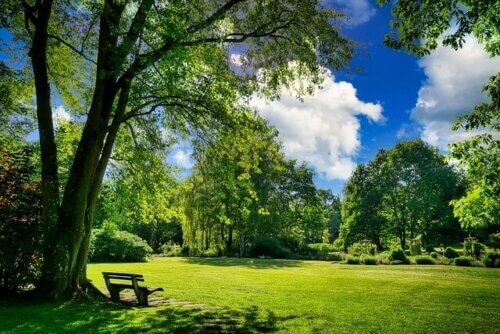State parks are treasures of natural beauty and cultural significance, offering a diverse range of outdoor experiences for individuals and families alike.
Spanning forests, mountains, beaches, and deserts, these protected areas provide a refuge for wildlife and a space for people to connect with nature. Visitors can explore miles of scenic trails, enjoy camping under starry skies, and partake in activities like fishing, kayaking, and birdwatching.
Beyond recreation, state parks often preserve historical landmarks and educate visitors about the region’s heritage. Whether seeking adventure, relaxation, or a deeper appreciation for the environment, state parks offer something for everyone.
State parks and national parks differ primarily in their management, scale, focus, and funding sources. Here’s a breakdown:
MANAGEMENT AND GOVERNANCE
State Parks: Managed by state governments and their respective state park agencies. Rules, fees, and resources vary by state.
National Parks: Managed by the federal government through the National Park Service (NPS), a branch of the U.S. Department of the Interior. They follow uniform federal guidelines.
SCALE AND SCOPE
State Parks: Typically smaller and more localized, focusing on preserving natural beauty, cultural heritage, and recreational opportunities within the state.
National Parks: Larger and often encompassing areas of national or global significance, protecting unique ecosystems, landscapes, or historic sites on a broader scale.
FOCUS
State Parks: Often prioritize recreational activities such as hiking, camping, picnicking, and local education. They may focus on serving the immediate needs of their state’s residents and visitors.
National Parks: Primarily aim to preserve and protect unique natural features, biodiversity, and historic landmarks for future generations. They also emphasize conservation and scientific research.
FUNDING
State Parks: Funded by state budgets, visitor fees, and sometimes local partnerships or donations.
National Parks: Federally funded through Congressional appropriations, visitor fees, and partnerships with nonprofit organizations like the National Park Foundation.
RECOGNITION AND STATUS
State Parks: Highlight regional or state-level significance.
National Parks: Recognized for their national and international importance, often drawing visitors from around the world.
State parks serve a more localized purpose with a focus on regional natural and cultural resources, while national parks protect areas of national significance and often cater to a broader audience. Both, however, play vital roles in preserving the environment and providing opportunities for outdoor enjoyment.
WHAT PEOPLE LIKE ABOUT STATE PARKS VS. NATIONAL PARKS
STATE PARKS:
ACCESSIBILITY
Proximity: State parks are often closer to residential areas, making them more convenient for day trips or weekend visits.
Affordability: Entrance and camping fees are generally lower than those of national parks, appealing to budget-conscious visitors.
RECREATION
Family-Friendly Activities: Visitors appreciate amenities like picnic areas, playgrounds, and boat rentals, ideal for family outings.
Outdoor Sports: Opportunities for fishing, mountain biking, horseback riding, and paddling attract outdoor enthusiasts.
LOCAL CHARM
Regional Focus: State parks often showcase unique local landscapes, flora, and fauna, offering a more intimate connection with a specific area.
Cultural Heritage: Many state parks preserve regional history, such as old battlefields, historic buildings, and indigenous sites, which are fascinating to history buffs.
CROWD LEVELS
Tranquility: State parks tend to be less crowded than national parks, providing a peaceful retreat.
YEAR-ROUND ACCESS
Seasonal Appeal: Visitors often enjoy state parks year-round, with activities ranging from summer swimming to winter snowshoeing.
NATIONAL PARKS:
ICONIC LANDSCAPES
Breathtaking Scenery: National parks like Yellowstone, Grand Canyon, and Yosemite draw visitors with awe-inspiring landscapes of national and global significance.
Unique Ecosystems: Visitors are drawn to features like geysers, towering peaks, vast deserts, and ancient forests.
PRESERVATION
Untouched Wilderness: People value the pristine, protected environment, allowing them to experience nature at its purest.
Endangered Species: Wildlife enthusiasts enjoy the chance to see rare animals in their natural habitats.
BUCKET-LIST DESTINATIONS
Global Appeal: National parks often serve as major travel goals for adventurers and tourists worldwide.
Photogenic Locations: The stunning landscapes are a favorite for photographers and social media enthusiasts.
EDUCATIONAL EXPERIENCES
Ranger-Led Programs: National parks provide guided tours, wildlife talks, and educational activities for all ages.
Visitor Centers: Informative exhibits and multimedia presentations enrich visitors’ understanding of the park’s significance.
ADVENTURE OPPORTUNITIES
Epic Trails: Challenging hikes, backcountry camping, and multi-day treks attract experienced adventurers.
Grand Scale: The vastness of many national parks allows for extended exploration.
COMPARISON OF PREFERENCES
State Parks: Loved for their local charm, affordability, and accessibility. Ideal for casual visitors, families, and those seeking a quick nature fix or recreational activities close to home.
National Parks: Celebrated for their grandeur, educational opportunities, and iconic status. They attract both domestic and international travelers looking for once-in-a-lifetime experiences and majestic beauty.
Both types of parks provide invaluable spaces for recreation, learning, and nature appreciation, catering to different needs and preferences.
State parks and national parks are generally safe for visitors, but safety can vary depending on factors like location, size, terrain, wildlife, and visitor behavior. Both types of parks have measures in place to ensure safety, but there are some differences in resources and challenges. Here’s a breakdown:
SAFETY IN STATE PARKS
Strengths:
Smaller Size: Many state parks cover less area, making it easier for park staff to monitor and maintain safety.
Accessibility: State parks are often closer to urban areas, providing quicker access to emergency services.
Lower Traffic: Fewer visitors may mean less competition for resources like rangers or medical assistance in case of an emergency.
Well-Marked Trails: Trails are typically shorter and better marked, reducing the risk of getting lost.
Challenges:
Fewer Resources: State parks may have smaller budgets, resulting in fewer rangers or less advanced emergency response capabilities compared to national parks.
Regional Hazards: Depending on the location, some state parks may have unique risks, like unstable cliffs, strong currents, or wild animals.
SAFETY IN NATIONAL PARKS
Strengths:
Well-Funded Operations: National parks often have larger budgets and more staff, including specialized rangers trained in emergency response and search-and-rescue operations.
Visitor Education: National parks provide extensive safety information, including ranger-led programs, signage, and brochures to help visitors prepare for potential risks.
Advanced Facilities: Many national parks have visitor centers with first aid stations and access to communication tools in remote areas.
Challenges:
Remote Locations: Some national parks are in isolated areas, making emergency response slower in certain parts of the park.
Larger Crowds: High visitor numbers in popular parks can lead to accidents or delays in emergency response.
Diverse Terrain: Larger parks often have more rugged and dangerous environments, such as high-altitude trails, extreme weather, and active geothermal areas.
KEY SAFETY TIPS FOR BOTH
Plan Ahead: Know the park’s layout, rules, and potential hazards before visiting.
Follow Rules: Stay on marked trails, adhere to wildlife viewing guidelines, and obey park regulations.
Prepare for the Environment: Bring appropriate gear, sufficient water, and a first aid kit.
Check Weather Conditions: Be aware of sudden weather changes, especially in remote or mountainous areas.
Inform Someone: Let others know your itinerary, especially if visiting remote sections of a park.
Utilize Park Resources: Consult with rangers or visitor centers for safety advice tailored to the specific park.
Both state and national parks are designed to provide safe environments for visitors, but the level of resources and potential risks can vary. By staying informed and prepared, you can enjoy a safe and memorable experience in either type of park.
State parks are rich in history, culture, and recreational opportunities. Beyond being places of natural beauty, they often have unique features that make them appealing to a wide range of visitors. Here are some other notable aspects of state parks:
Diversity of Landscapes
State parks showcase the varied geography of their respective regions, including forests, wetlands, mountains, beaches, caves, rivers, and prairies.
Examples include Hunting Island State Park in South Carolina, known for its beaches and lighthouse, and Dead Horse Point State Park in Utah, with its stunning desert views.
Historical and Cultural Significance
Many state parks protect important historical landmarks, such as battlefields, old forts, and Native American sites.
Some parks highlight local history through museums, interpretive trails, or reenactments.
Fort Delaware State Park (Delaware) preserves a Civil War-era fort.
Mesa Verde State Park (Colorado) offers insights into ancient Puebloan culture.
Unique Wildlife and Ecosystems
State parks provide habitats for local wildlife and often include interpretive programs to educate visitors about native species.
Birdwatchers, for example, frequent parks like Evergreen Lake State Park (Colorado) or Point Lobos State Natural Reserve (California) for rare sightings.
Recreation for All Seasons
State parks offer activities year-round, from summer hiking, swimming, and boating to winter sports like cross-country skiing and snowshoeing.
Parks often include family-friendly facilities like campgrounds, cabins, and picnic shelters.
Community Involvement
Many state parks host volunteer programs where people can participate in conservation efforts, trail maintenance, or educational outreach.
Events like guided hikes, stargazing nights, and community festivals strengthen the connection between parks and local residents.
Educational Opportunities
State parks are ideal for school field trips, nature camps, and workshops, teaching visitors about ecology, geology, and conservation.
Interpretive signs and visitor centers enhance learning experiences for self-guided visitors.
Economic Impact
State parks boost local economies by attracting tourists who spend money on lodging, food, and outdoor gear.
Some parks, like Niagara Falls State Park (New York), draw millions of visitors annually, significantly contributing to the region’s economy.
Conservation and Sustainability
Many state parks emphasize protecting natural and cultural resources while promoting sustainable practices.
Programs such as invasive species removal and habitat restoration are common in state parks.
Accessibility
State parks often aim to be inclusive by providing ADA-compliant trails, accessible campgrounds, and adaptive recreation programs for people with disabilities.
Affordable Outdoor Experiences
Compared to national parks, state parks are generally more affordable, offering low-cost or free entrance fees and reasonably priced activities like camping and boating.
State parks are more than just scenic retreats; they are vital cultural, educational, and recreational assets that enhance the quality of life for their visitors and protect regional natural resources for future generations.
TOP STATE PARKS IN EACH STATE
Alabama
Gulf State Park
- Why It’s the Best: Stunning beaches, diverse ecosystems, and modern facilities.
- Activities: Beachcombing, kayaking, biking on paved trails, fishing, and wildlife viewing.
Alaska
Chugach State Park
- Why It’s the Best: One of the largest state parks, offering breathtaking wilderness near Anchorage.
- Activities: Hiking, camping, glacier viewing, and wildlife spotting (e.g., bears, moose).
Arizona
Slide Rock State Park
- Why It’s the Best: Known for its natural water slides in a scenic red rock setting.
- Activities: Swimming, sliding on the rocks, picnicking, and photography.
Arkansas
Petit Jean State Park
- Why It’s the Best: Arkansas’s first state park, renowned for its waterfalls and rugged beauty.
- Activities: Hiking, camping, fishing, and exploring caves.
California
Point Lobos State Natural Reserve
- Why It’s the Best: Unparalleled coastal scenery and abundant marine life.
- Activities: Hiking, scuba diving, birdwatching, and photography.
Colorado
Eldorado Canyon State Park
- Why It’s the Best: World-class rock climbing and stunning views of canyon walls.
- Activities: Climbing, hiking, picnicking, and wildlife viewing.
Connecticut
Devil’s Hopyard State Park
- Why It’s the Best: Home to Chapman Falls and a rich mix of hiking trails.
- Activities: Hiking, fishing, picnicking, and birdwatching.
Delaware
Cape Henlopen State Park
- Why It’s the Best: Combines beaches with history, including a World War II observation tower.
- Activities: Swimming, biking, fishing, and visiting historical exhibits.
Florida
Honeymoon Island State Park
- Why It’s the Best: Pristine beaches and abundant wildlife, including ospreys.
- Activities: Beachgoing, kayaking, hiking, and birdwatching.
Georgia
Providence Canyon State Park
- Why It’s the Best: Nicknamed “Georgia’s Little Grand Canyon” for its striking geological formations.
- Activities: Hiking, photography, and geology tours.
Hawaii
Waimea Canyon State Park
- Why It’s the Best: Known as the “Grand Canyon of the Pacific.”
- Activities: Hiking, sightseeing, and photography.
Idaho
Farragut State Park
- Why It’s the Best: Located on the shores of Lake Pend Oreille with diverse recreation options.
- Activities: Boating, hiking, camping, and disc golf.
Illinois
Starved Rock State Park
- Why It’s the Best: Famous for its sandstone canyons and waterfalls.
- Activities: Hiking, picnicking, and birdwatching.
Indiana
Turkey Run State Park
- Why It’s the Best: Known for its sandstone gorges and scenic trails.
- Activities: Hiking, canoeing, horseback riding, and camping.
Iowa
Maquoketa Caves State Park
- Why It’s the Best: Features a network of caves and hiking trails in a picturesque setting.
- Activities: Cave exploration, hiking, and picnicking.
Kansas
Kanopolis State Park
- Why It’s the Best: Kansas’s first state park, featuring rugged canyons and scenic lake views.
- Activities: Hiking, biking, fishing, and horseback riding.
Kentucky
Cumberland Falls State Resort Park
- Why It’s the Best: Known as the “Niagara of the South,” with a unique moonbow phenomenon.
- Activities: Hiking, horseback riding, fishing, and photography.
Louisiana
Fontainebleau State Park
- Why It’s the Best: Located on Lake Pontchartrain, with beautiful marshlands and oak trees.
- Activities: Camping, hiking, birdwatching, and kayaking.
Maine
Camden Hills State Park
- Why It’s the Best: Stunning views of Penobscot Bay from Mount Battie.
- Activities: Hiking, camping, and scenic drives.
Maryland
Swallow Falls State Park
- Why It’s the Best: Features Maryland’s highest waterfall, Muddy Creek Falls.
- Activities: Hiking, camping, and photography.
Massachusetts
Mount Greylock State Reservation
- Why It’s the Best: The highest point in Massachusetts with panoramic views.
- Activities: Hiking, camping, and scenic drives.
Michigan
Porcupine Mountains Wilderness State Park
- Why It’s the Best: One of the largest wilderness areas in the Midwest with breathtaking views.
- Activities: Hiking, skiing, backpacking, and wildlife viewing.
Minnesota
Itasca State Park
- Why It’s the Best: Home to the headwaters of the Mississippi River.
- Activities: Hiking, biking, kayaking, and camping.
Mississippi
Tishomingo State Park
- Why It’s the Best: Unique rock formations and historic significance.
- Activities: Rock climbing, hiking, canoeing, and fishing.
Missouri
Ha Ha Tonka State Park
- Why It’s the Best: Features castle ruins and karst landscapes.
- Activities: Hiking, photography, and exploring natural bridges.
Montana
Makoshika State Park
- Why It’s the Best: Known for its rugged badlands and dinosaur fossils.
- Activities: Hiking, fossil hunting, and camping.
Nebraska
Smith Falls State Park
- Why It’s the Best: Home to Nebraska’s tallest waterfall.
- Activities: Hiking, kayaking, and camping.
Nevada
Valley of Fire State Park
- Why It’s the Best: Stunning red sandstone formations and ancient petroglyphs.
- Activities: Hiking, photography, and stargazing.
New Hampshire
Franconia Notch State Park
- Why It’s the Best: Nestled in the White Mountains with dramatic scenery.
- Activities: Hiking, swimming, and visiting the Flume Gorge.
New Jersey
Island Beach State Park
- Why It’s the Best: A pristine barrier island with beautiful beaches and dunes.
- Activities: Swimming, fishing, kayaking, and birdwatching.
New Mexico
City of Rocks State Park
- Why It’s the Best: Features unique volcanic rock formations.
- Activities: Rock climbing, hiking, and stargazing.
New York
Letchworth State Park
- Why It’s the Best: Known as the “Grand Canyon of the East,” with stunning waterfalls.
- Activities: Hiking, hot air ballooning, and camping.
North Carolina
Hanging Rock State Park
- Why It’s the Best: Features dramatic cliffs and waterfalls.
- Activities: Hiking, rock climbing, and swimming.
North Dakota
Theodore Roosevelt State Park
- Why It’s the Best: Celebrates Roosevelt’s conservation legacy and features badlands terrain.
- Activities: Hiking, horseback riding, and wildlife viewing.
Ohio
Hocking Hills State Park
- Why It’s the Best: Renowned for its caves, cliffs, and waterfalls.
- Activities: Hiking, zip-lining, and camping.
Oklahoma
Beavers Bend State Park
- Why It’s the Best: Nestled in the Ouachita Mountains with a serene river and forest setting.
- Activities: Fishing, kayaking, hiking, and camping.
Oregon
Silver Falls State Park
- Why It’s the Best: Known for the “Trail of Ten Falls,” with breathtaking waterfalls.
- Activities: Hiking, photography, picnicking, and camping.
Pennsylvania
Ohiopyle State Park
- Why It’s the Best: Features the Youghiogheny River for whitewater rafting and scenic waterfalls.
- Activities: Rafting, kayaking, hiking, and rock climbing.
Rhode Island
Colt State Park
- Why It’s the Best: Offers panoramic ocean views and manicured gardens.
- Activities: Walking, biking, picnicking, and fishing.
South Carolina
Hunting Island State Park
- Why It’s the Best: A barrier island with unspoiled beaches and a historic lighthouse.
- Activities: Beachcombing, hiking, fishing, and wildlife observation.
South Dakota
Custer State Park
- Why It’s the Best: Known for its bison herd and picturesque Black Hills scenery.
- Activities: Wildlife viewing, hiking, fishing, and scenic drives.
Tennessee
Fall Creek Falls State Park
- Why It’s the Best: Features one of the highest waterfalls in the eastern U.S.
- Activities: Hiking, zip-lining, fishing, and camping.
Texas
Palo Duro Canyon State Park
- Why It’s the Best: The “Grand Canyon of Texas,” with dramatic canyon landscapes.
- Activities: Hiking, biking, horseback riding, and camping.
Utah
Dead Horse Point State Park
- Why It’s the Best: Offers breathtaking views of the Colorado River and red rock landscapes.
- Activities: Hiking, mountain biking, and stargazing.
Vermont
Smugglers’ Notch State Park
- Why It’s the Best: Nestled in the Green Mountains with dramatic rock formations.
- Activities: Hiking, rock climbing, and camping.
Virginia
First Landing State Park
- Why It’s the Best: Combines historical significance with beach and forest ecosystems.
- Activities: Hiking, swimming, kayaking, and exploring historical sites.
Washington
Deception Pass State Park
- Why It’s the Best: Famous for its dramatic bridge and views of Puget Sound.
- Activities: Hiking, boating, birdwatching, and fishing.
West Virginia
Blackwater Falls State Park
- Why It’s the Best: Known for its iconic Blackwater Falls and striking forest scenery.
- Activities: Hiking, photography, and cross-country skiing.
Wisconsin
Devil’s Lake State Park
- Why It’s the Best: Features a glacially carved lake surrounded by cliffs and forests.
- Activities: Rock climbing, hiking, swimming, and camping.
Wyoming
Hot Springs State Park
- Why It’s the Best: Known for its mineral hot springs and free public bathhouses.
- Activities: Soaking in hot springs, hiking, and wildlife observation.
State parks are often designed to offer a wide range of outdoor activities that cater to different interests. Common activities include:
Fishing: Many state parks are built around lakes, rivers, or streams, making them perfect for fishing enthusiasts.
Camping: From primitive sites to modern RV hookups, state parks usually have options for all types of campers.
Hiking: State parks are known for their diverse trail systems, ranging from easy walks to challenging treks.
Boating and Kayaking: Parks with lakes or rivers often offer boat rentals or access points for personal watercraft.
Wildlife Watching: Many parks preserve habitats for local wildlife, offering excellent opportunities for birdwatching and photography.
Picnicking: Nearly every state park has picnic areas, often with scenic views or near playgrounds for families.
Swimming: Some parks have designated beaches or swimming areas, especially during warmer months.
Rock Climbing: Parks with cliffs or unique geological features often draw climbers.
State parks are popular because they provide these activities in a setting that is usually closer and more accessible than national parks, making them ideal for quick day trips or weekend getaways.
In many cases, there is an entry fee to get into state parks, but the fees can vary depending on the state and the specific park. Here are some common fee structures:
Entrance Fees: Some state parks charge a daily entrance fee, which could range from a few dollars to around $10–$20 per vehicle. This often covers access to the park and its basic facilities.
Camping Fees: If you’re camping, there may be an additional fee for campsites, especially if the park offers amenities like electricity, water hookups, or modern restrooms.
Special Activities Fees: Certain activities, like boat rentals, guided tours, or renting a cabin, may have extra charges.
State Park Passes: Many states offer annual or multi-visit passes that allow unlimited access to state parks for a set price. These passes can be a good option if you plan to visit multiple parks in a year.
Free Days or Special Offers: Some parks have free admission on certain days or for specific groups (e.g., veterans, senior citizens, or children).
It’s always a good idea to check the state park’s website or contact the park directly for specific details about fees, discounts, and any special offers.
Many state parks host a variety of events, festivals, concerts, and other special activities throughout the year. These events can be a great way to experience the park in a unique way while enjoying additional activities. Here are some common types of events you might find at state parks:
Nature Walks and Educational Programs: Many state parks offer guided hikes, birdwatching tours, and nature walks to help visitors learn more about the local environment and wildlife.
Festivals: Parks often host seasonal festivals that celebrate the area’s culture, history, or natural beauty. These can include harvest festivals, wildflower festivals, or environmental awareness events.
Outdoor Concerts: Some state parks, especially those near larger cities, organize summer concerts, featuring local musicians or even larger acts in scenic outdoor settings.
Holiday Events: During the holidays, state parks may host special events, like Halloween-themed activities, Christmas light displays, or Easter egg hunts.
Recreational Competitions: Parks sometimes hold competitions such as fishing tournaments, trail races, triathlons, or rock climbing events.
Workshops and Classes: Educational classes or workshops, such as photography lessons, art workshops, or survival skills training, may be offered.
Cultural and Historical Events: Some parks that have historical significance offer reenactments, storytelling, or celebrations of local heritage.
Volunteer Days: Many state parks organize volunteer clean-up days, tree-planting events, or conservation projects where the public can help with park maintenance.
To find out about specific events, it’s a good idea to check the state park’s official website or social media pages. Events can be seasonal, so looking ahead or planning your visit during certain times of the year might enhance your experience.
WHILE NATIONAL PARKS ARE INCREDIBLE AND OFTEN OFFER UNIQUE, LARGER-SCALE NATURAL EXPERIENCES, STATE PARKS HAVE A LOT TO OFFER TOO AND CAN SOMETIMES BE EVEN MORE ACCESSIBLE AND VARIED. HERE ARE A FEW REASONS WHY PEOPLE SHOULD CONSIDER CHECKING OUT STATE PARKS:
Local Access and Convenience: State parks are often closer to home, making them perfect for day trips or weekend getaways without the long travel times required for many national parks.
Affordability: With generally lower entrance and activity fees, state parks can be more budget-friendly, especially if you plan to visit more than once or camp for a longer stay.
Diverse Activities: Many state parks offer similar activities to national parks, like hiking, fishing, camping, and boating. Plus, they often feature local wildlife, unique ecosystems, and cultural history that may not be found in larger, more crowded national parks.
Fewer Crowds: State parks tend to be less crowded than national parks, which can provide a more peaceful and private experience, especially during peak tourist seasons.
Local Events: State parks host a variety of special events, festivals, concerts, and educational programs, allowing visitors to experience their local culture and environment in a fun, interactive way.
Family-friendly and Accessible: Many state parks are designed to cater to families, including facilities like picnic areas, playgrounds, and easy trails for young children or people with limited mobility.
Wildlife and Scenic Views: Just like national parks, state parks offer breathtaking views and opportunities to observe wildlife. Many parks are situated in beautiful areas—mountains, forests, rivers, and lakes—providing a perfect setting for outdoor activities.
If you’re looking to get outdoors, enjoy nature, and take part in recreational activities without the hustle and bustle of a national park, state parks are definitely worth exploring!
To explore more about state parks, including details on specific parks, events, activities, and fees, here are some reliable resources you can check out:
- State Park Websites:
- Each state has its own official state park system website, where you can find detailed information on all the parks within that state, including maps, activities, camping reservations, and event schedules.
- Example: California State Parks (https://www.parks.ca.gov), Florida State Parks (https://www.floridastateparks.org).
- National Association of State Park Directors (NASPD):
- The NASPD website (https://www.stateparks.org) provides information about state parks across the U.S., including resources on events, conservation, and visitor tips.
- Reserve America:
- Reserve America (https://www.reserveamerica.com) is a platform that allows you to check availability for campgrounds, book campsites, and explore activities in state parks.
- State Tourism Websites:
- Many states have tourism websites that provide information on all types of parks and attractions within the state, including state parks. These can include details on special events, festivals, and more.
- Example: Visit Utah (https://www.visitutah.com), Visit Oregon (https://www.traveloregon.com).
- Outdoor Recreation Websites:
- Websites like AllTrails (https://www.alltrails.com) and Hiking Project (https://www.hikingproject.com) feature trail information and user reviews for state parks across the country. They often include hiking routes, difficulty levels, and scenic highlights.
- Local Park Systems:
- In addition to state-run parks, many cities and counties manage parks. Look up local or regional park systems in your area for more specific information about nearby nature preserves or outdoor spaces.
These resources should give you a good starting point to explore the incredible offerings of state parks across the U.S.!
If you liked this Share It!
Unleash your BOHOtude – visit BOHOtude Apparel for a selection of free-spirited apparel.




















